The 2021 season is still young, but there have already been quite a few good stories. Whether you like to see a no-hitter, even a second no-hitter, an early Rule 5 Draft success story, a historical start, or journeymen resurrecting their career, there has been no shortage of storylines and entertainment already this year.
Huascar Ynoa has been another good story at the beginning of the season. The Atlanta Braves acquired him in what looked like an innocuous trade from the Twins back in 2017 for rental pitcher Jaime Garcia. Ynoa was probably viewed as a typical lottery ticket type of prospect that would be expected to come back in a trade like that, as Ynoa was just 19-years-old at the time of the trade and not yet out of rookie ball. He began developing some serious strikeout ability upon landing in the Braves system, but without consistent enough command was always viewed as a fringey starter prospect with significant reliever risk.
Ynoa has broken that mold to start the year. 2021 is actually the third Major League season he’s been a part of, although you’d be forgiven if you didn’t realize that, as his previous cameos have been both brief and lackluster. His 5.82 ERA and 4.90 FIP in 21.2 innings pitched last season definitely doesn’t scream anything overly impressive. Fast forward to the present day though, and that narrative is quickly changing due to how he’s started the 2021 season. He’s been mostly good this season, appearing in four games and making three starts, with a 3.94 ERA and 2.62 SIERA, and he has started to display some of that excellent strikeout ability that he showed in the minors, with a strikeout rate of 31.7%, the highlight of which coming with a ten strikeout performance against the Marlins on April 12th. He struggled in the start after that on April 17th against a struggling Cubs offense, but without a doubt, Ynoa has made an impression already on this young season. Let’s dive in and talk about Ynoa thus far and see what his profile as a pitcher looks like and what we may have to look forward to in the future from him.
Wipeout Slider
When first looking at Ynoa’s pitch repertoire, it’s clear that his slider is his go-to, bread-and-butter pitch. That was the case as a prospect, that was the case during his pre-2021 Major League appearances, and that has been the case so far this year. We can be brief when it comes to his slider–it’s not going to be the main point of this post. The pitch is good, and the pitch is definitely a part of his early success, but it’s been good in the past and it hasn’t changed all that much. Ynoa has made some other changes and improvements that are important and will be discussed, however, I do want to take some time first and appreciate this pitch visually for a bit because hot dang it’s impressive:
The pitch definitely gives hitters fits. The video probably speaks for itself and shows that it’s a good pitch, but let’s dive in a little bit more. It’s definitely a power slider as it clocks in at around 85 miles-per-hour on average, rather than one that relies more on bend. Its usage is pretty much even with his fastball at 39% against 42% on the fastball, and for good reason as the pitch gets a ton of whiffs. Last year, it had a 37.4% whiff rate, this year it’s up to an even more impressive 40.8%-which is one of the ten-highest in baseball. It’s not just about whiffs though, Ynoa is able to throw the pitch for strikes when he needs to, and gets a fair amount of called strikes which helps lead him to an overall 41.3% CSW rate on the pitch-good for fourth-best in the league. It looks like he’s been locating the pitch more consistently this season, as compared to last year when taking a look at the heatmaps. First, from 2020 and then 2021:
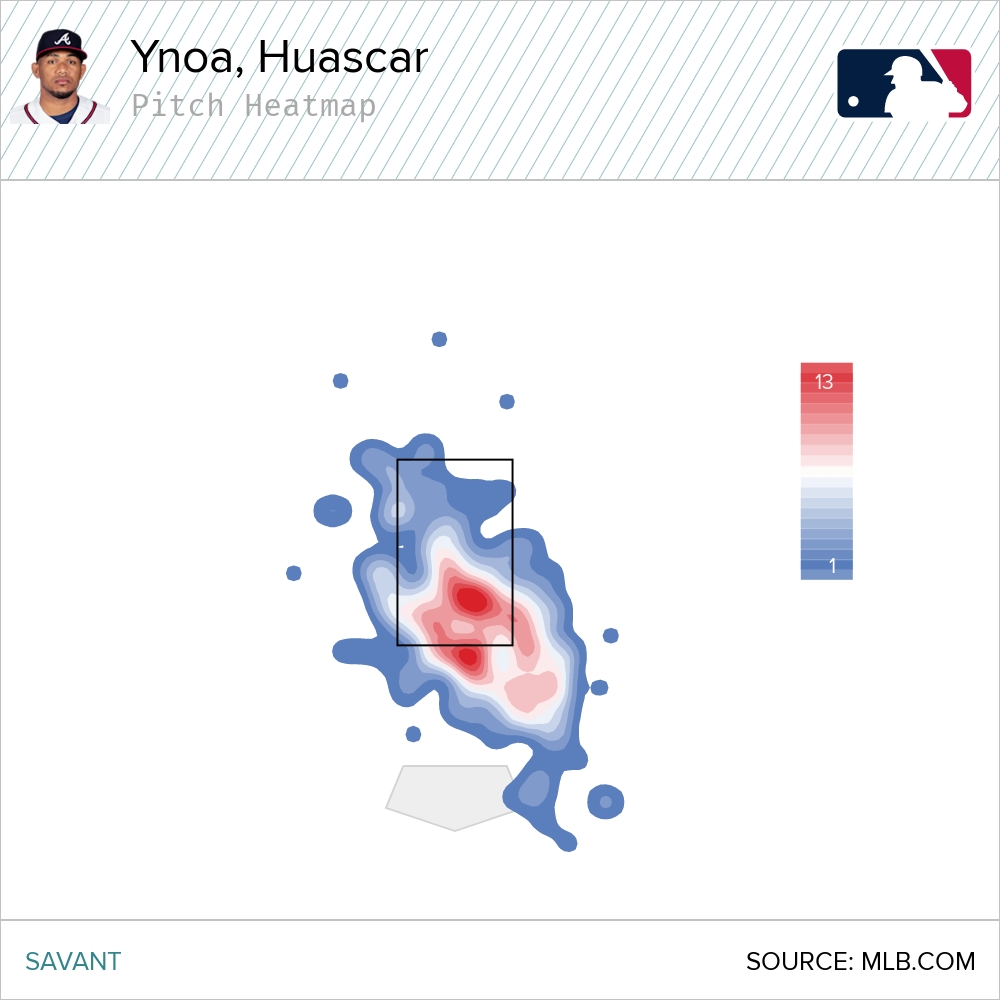
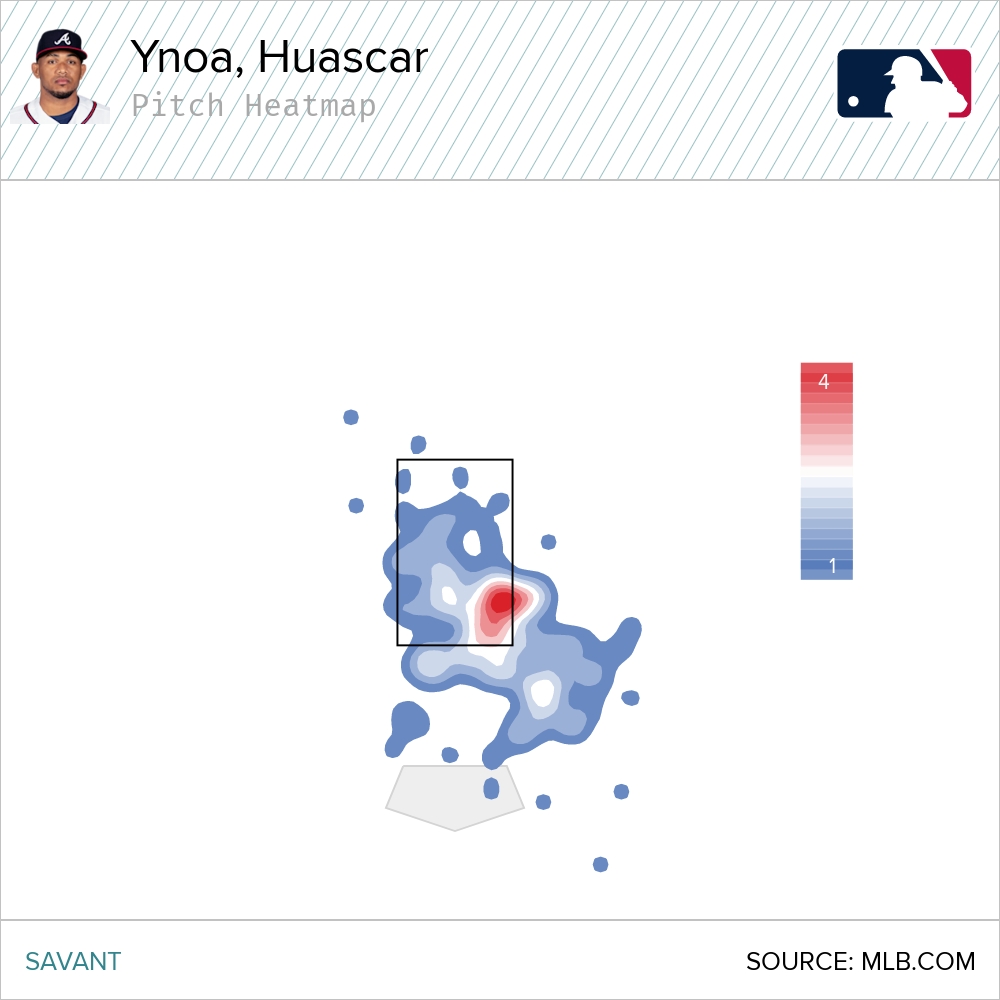
It looks like there have been fewer sliders hung up in the heart of the zone so far this year, which looked like something that was prevalent last year. It’s a pretty good combination–he has a slider that is one of the best in the game at getting whiffs, and it may still be getting better in other areas, as it looks like he’s locating it better in 2021. The pitch is great but again, that’s nothing new from Ynoa. It’s the focal point of his repertoire, but one great pitch alone likely isn’t going to cut it as a starter. There has to be something else to get excited about, and yes, there is. With that in mind, let’s take a look elsewhere at his repertoire.
Hot Fastball
It is pretty difficult for a starting pitcher to be successful without a quality fastball. Ynoa’s fastball, despite strong velocity at around 95 miles-per-hour, didn’t fare too well last season, with a pVAL of -2.2 in a small sample. One way to make a fastball better is to throw it faster. Ynoa showed up this spring and suddenly started doing that. It’s carried over to the regular season as one of the early velocity increases this year:
| Name | AVG FF Velocity 2021 | AVG FF Velocity 2020 | Difference |
|---|---|---|---|
| Justin Dunn | 93.9 | 91.2 | 2.7 |
| Brent Suter | 88.1 | 85.4 | 2.7 |
| Huascar Ynoa | 97.0 | 94.8 | 2.2 |
| Michael Fulmer | 95.4 | 93.2 | 2.2 |
| Dylan Bundy | 92.2 | 90.0 | 2.2 |
Of course, Ynoa is coming from a better starting point than most pitchers, including among the other pitchers in this table. His 94.8 miles-per-hour from last year is definitely still strong but it is now even better. Going from around 95 to 97 is just icing on the cake, and puts him in the elite fastball velocity camp, as opposed to some of the other pitchers on this list, who may be better but are just getting closer to league average.
More fastball velocity is definitely a plus, but in addition to the uptick in speed, Ynoa has been locating the pitch differently. First, take a look at his fastball heatmap from 2019 and 2020:
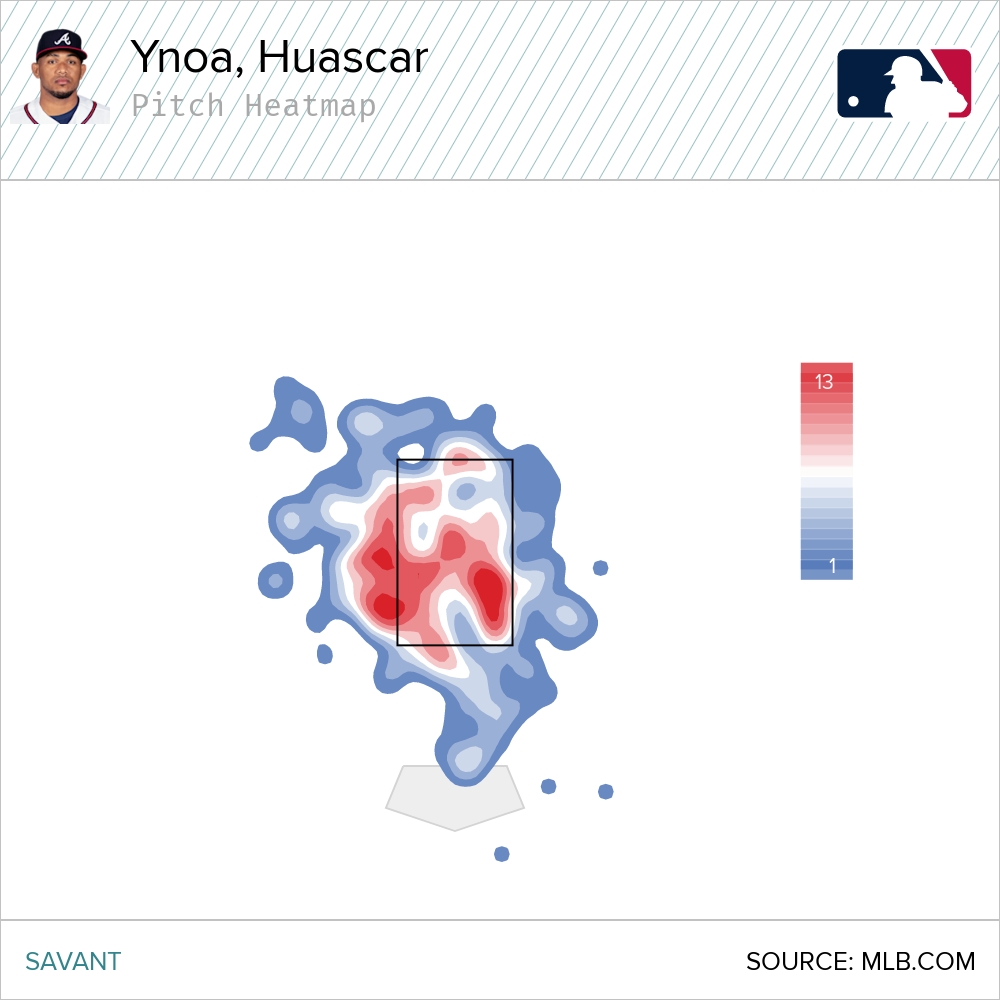
Now, compare that to his fastball heatmap so far this year:
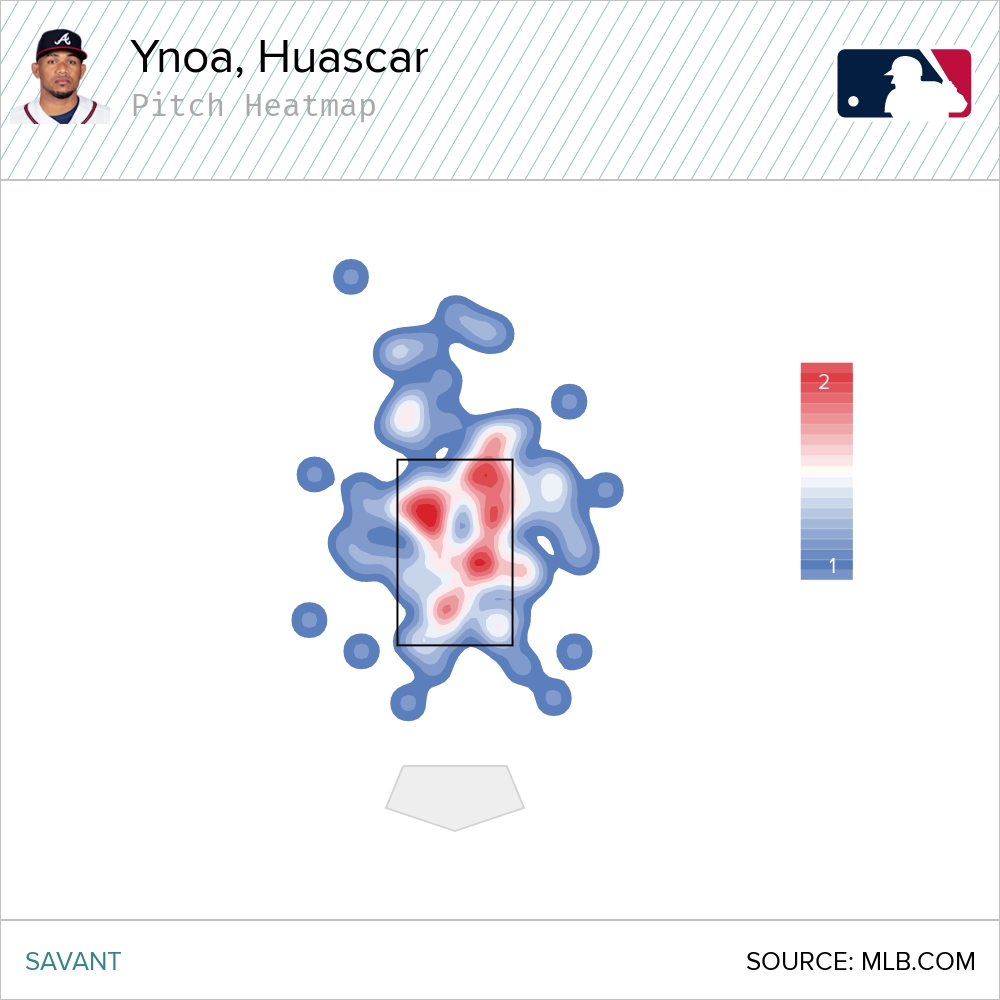
Compared to his limited looks pre-2021, we can see two things. First and foremost, it looks like Ynoa is landing more fastballs in the zone, and of those pitches in the zone, more of them appear to be up in the zone, as it looks like Ynoa has made an effort to follow the “fastballs up” strategy–which is a popular one these days. Admittedly, this plot did look better before his third start against the Cubs. It was absolutely beautiful with a great helping of dark red at the top portion of the zone, but this is still quite good and an encouraging sign to see from the youngster, as it looks like he knows where he should be deploying that added velocity, as the top of the zone is where, unsurprisingly, he has gotten most of the whiffs on the pitch:
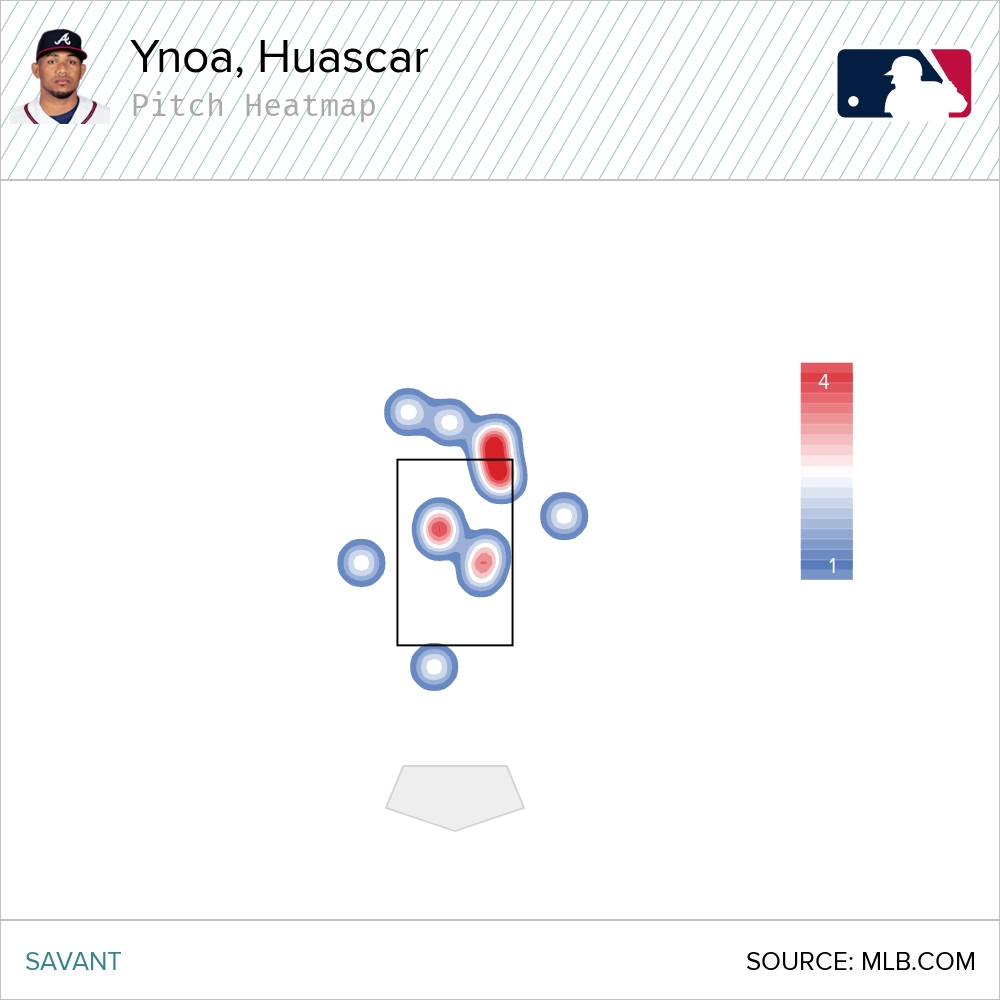
That bit of extra rise this year is also due to the fact that Ynoa’s fastball has such a high rate of active spin. Last season, Ynoa’s active spin rate was a whopping 99.5%, meaning that 99.5% of his fastball spin contributed to the pitch’s movement. It’s hard to get better than 99.5% so that clearly put Ynoa near the very top of the leaderboard. Ynoa has remained strong in this department this season, although it isn’t as exceptional as 99.5%–he’ll have to settle for just 97.6%, which is still among the best in the game. A higher rate of active spin leads to more rise on a fastball, so this is also a contributing factor towards Ynoa’s higher rate of fastballs up in the zone this year. Essentially, Ynoa is taking better advantage of his active spin, and the whiffs on the pitch are coming at a much higher rate (and at one of the highest rates among starting pitchers):
| Season | # FF | FF Whiff% |
|---|---|---|
| 2020 | 174 | 11.0% |
| 2021 | 99 | 31.7% |
Release Point and Control
In addition to the changes with his fastball, the other most noticeable change from Ynoa this season has come from where he is releasing his pitches and it may be one of the biggest reasons for his fastball’s newfound success, as well as his overall control gains–more on that a little later.
I wish it were a bit more scientific, but it really just seems like the Braves have encouraged him to change his release point and delivery. Just looking at the release point visualizations from 2020 and comparing them to 2021, the difference on the fastball (in red) is quite noticeable:
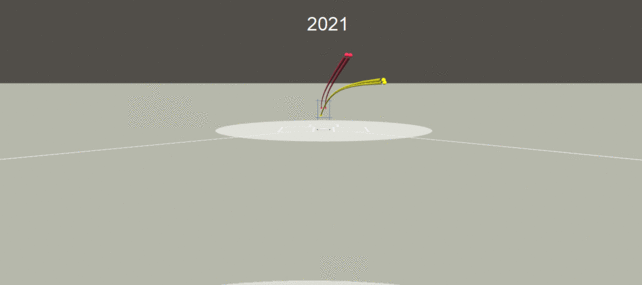
Indeed, it looks like Ynoa’s release point on the fastball has been raised quite a bit this year as opposed to last year. It’s still not perfect, as the release point of his slider strays from the release point of the fastball, but that in itself isn’t worrying on its own. It would be nice, but it is not always necessary for a pitcher to match up the release points.
What that change in release point perhaps does do is have an effect on Ynoa’s control, which has seen some early improvement this season. Explosive stuff doesn’t always equal great results, as a starting pitcher ultimately needs to throw enough strikes to get through the lineup. Ynoa has been doing a much better job of this so far, which is encouraging because his control-or lack thereof-was always his biggest red flag as a prospect and ultimately what many thought would hold him back from being a true starting pitcher.
When it comes to Ynoa’s control this season, it does sort of go hand-in-hand with what we looked at earlier in how excellent he has been at locating fastballs up in the zone so far, as being able to locate pitches where you want them to is an important part of control, to say the least. Overall, Ynoa’s control has been much improved this year. He’s been landing both more pitches in the zone in total as well as with the fastball, which has helped him earn more called strikes and fewer walks:
| Season | FF Zone % | Overall Zone % | CallStr% | BB% |
|---|---|---|---|---|
| 2020 | 44.6 | 45.1 | 15.2 | 13.0 |
| 2021 | 58.6 | 51.7 | 19.1 | 4.8 |
Additionally, when balls are hit off of Ynoa, a lot of them go on the ground. This has carried over from last year, but in the early part of the season, Ynoa’s groundball rate is 55%, which as of the time of writing, is one of the top-ten highest rates among starting pitchers, and we all love when a pitcher serves up groundballs, even more so when paired with a ton of strikeouts as Ynoa does. These certainly look like steps in the right direction for Ynoa thus far.
Red Flags
So, we have more velocity, more whiffs, better control, and a lot of groundballs. What’s not to like? While Ynoa does have a pretty good and encouraging profile as a pitcher as-is, there are still some things that should cause some pumping of the brakes, at least right now.
You’ll notice that when I ran through his repertoire I didn’t mention a third pitch from Ynoa–just his fastball and slider. That’s because while Ynoa throws four pitches per Baseball Savant (a sinker and a changeup as the other two), their usage has been extremely limited. His go-to fastball-slider combination makes up roughly 80% of the total pitches he throws, and he sprinkles in the occasional sinker and changeup every now and then. It’s usually expected for a starting pitcher to have at least three pitches to help them navigate multiple times through a lineup. Granted, most starters don’t have two legitimate strikeout offerings as Ynoa does, but still, a Ynoa with a true third pitch would be better than one without.
The sinker is definitely the most used of the other two at 13.6% usage, so let’s discuss that one first. The pitch has seen a significant bump in usage this season (he threw just one sinker total per Baseball Savant in 2020), but its usage hasn’t been steady through his first three starts:
| Date | SI % |
|---|---|
| 4/7/2021 | 17.6% |
| 4/12/2021 | 1.2% |
| 4/17/2021 | 13.9% |
It is probably worth noting that the April 12th start was the best one of the season for Ynoa in which he struck out ten Marlins in six innings. He had his four-seamer and slider both working big time in that one, so it wasn’t all that necessary to filter in some sinkers, which probably explains the decreased usage in that one. The sinker does do what it is supposed to do in generate groundballs–57.1% groundball rate this year–but it does remain to be seen how much of a factor this pitch will be in the future, so I’m hesitant to call it a true third offering just yet, especially considering he only threw one such pitch last year.
The same goes for his changeup, of which he’s thrown just 13 so far, so I don’t want to generalize too much about it. It does have great active spin for whatever it’s worth (99% this year, 98% last year), but even with that, it still doesn’t move much, with pretty much average break and below-average drop. I do wonder if the pitch could be further developed in the future, but that is not likely to come this year. It may not be more than a token pitch in its current form, but it could at least be a nice change-of-pace pitch to show to opposite-handed hitters, but still, it’s not a true third pitch.
The lack of a true third pitch just emphasizes how much more important command and control will be for Ynoa to have success. It has been a strength for Ynoa thus far, but it could also regress to what his scouting reports have often told, and get to a point where the stuff alone won’t be able to cut it, which could eventually push him to relief. There’s very little margin for error with a profile like this, as he’ll have to locate well to cut it as a near-exclusive two-pitch pitcher.
Ynoa will have to especially locate his slider well, as hitters will be going into each plate appearance and count knowing that they’re essentially going to see one of two pitches, which could open the possibility for a hitter to sit on the slider and wait for a mistake. This is pretty much what happened to Ynoa on April 17th against the Cubs. He didn’t have both his four-seamer and slider working fully, and things kind of fell apart because of it. He still got a got amount of called strikes and whiffs, although not at the highs we’ve seen from him previously, and when he missed his location, he paid for it. Particularly in the third inning, he left a fastball in the heart of the plate, which Willson Contreras deposited into the seats for his second home run of the game:
Then, just a couple of batters later he missed with a slider that Javier Baez absolutely crushed, and suddenly a tough start got even worse:
Of course, Ynoa isn’t unique among pitchers in that his mistakes cause him trouble, but the difference with Ynoa is that when his main pitches weren’t working, there wasn’t really anything else he could turn to. He still had to throw fastballs and sliders, because that’s pretty much all he can throw, and the results weren’t pretty. There were more examples of the Cubs teeing off on Ynoa, but I think the point is made. This start against the Cubs was maybe an extreme example, but still is an example of how when things go wrong for Ynoa, they can get pretty ugly. After what was a blistering hot start to the season, perhaps it is maybe a good thing to see Ynoa come back down to earth for a start, as now we get a clearer look at his profile and how he doesn’t have much room for error due to that profile.
Conclusion
All in all, when evaluating Ynoa through the beginning of the season, there still has been more good than bad from him. Ynoa features two standout pitches and those may have gotten even better this year. His slider is getting more whiffs, his fastball is going faster than ever and due to changes with location, release point, and overall better control, is doing things it never had before, with an impressive rate of whiffs. Ynoa has two legitimately excellent offerings which make him such an intriguing pitcher and has taken some important steps forward already this year. Things look absolutely great when everything is clicking, as he showed in his first two starts of the year. However, when he’s off, things can get rough, as we saw in his start against the Cubs.
While there is a lot to like about Ynoa, it still remains to be seen if he can do it all consistently enough to hang in a starting rotation long term. Without a true third pitch, he’ll have to command and locate well, which is something he wasn’t exactly known for as a prospect. If things aren’t going well, or he simply just doesn’t have his stuff working on a particular day, it may be tough for him because there’s not much currently that he can do to switch things up with such a limited repertoire of pitches to choose from. Maybe the sinker or changeup will develop more and turn into a legitimate third pitch, but right now Ynoa’s profile, while encouraging is still one that is risky, and that is important to keep in mind as he gets his first extended run in the Majors. While the first impression was quite nice and the stuff is superb, Ynoa is still figuring things out, and there may be more bumps along the way.
Photo by Rich von Biberstein/Icon Sportswire | Adapted by Justin Redler (@reldernitsuj on Twitter)


Excellent analysis, thank you.
While I fully understand the risky profile, especially with only 2 pitches, what is your long-term outlook on Ynoa in a medium-depth dynasty league? Where would you rank him in relation to guys like Tarik Skubal or Triston McKenzie?
Hi Brian, thanks for reading. Glad you enjoyed it. Dynasty leagues aren’t my forte but long term, I would probably rank him below McKenzie and maybe level with Skubal. I do like Ynoa quite a bit, but his profile is risky and the other two were top 100 prospects and they were definitely more well regarded for a reason. If you have him, I would hold on to him, unless you can get something really good for him.